#Coronation Chair
Text

An artist's depiction of how the restored Coronation chair might look
#Coronation chair#Westminster Abbey#King Charles III#UK#monarchy#crown#mediaeval#British history#restoration
51 notes
·
View notes
Text
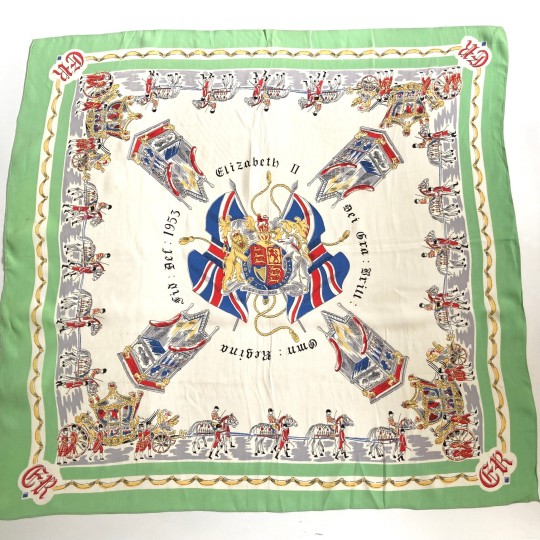
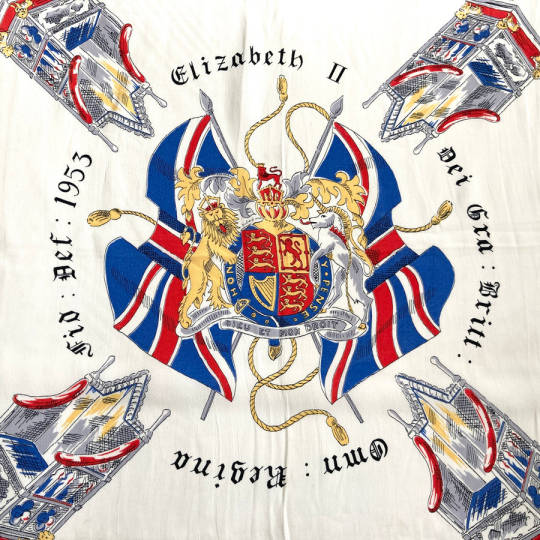
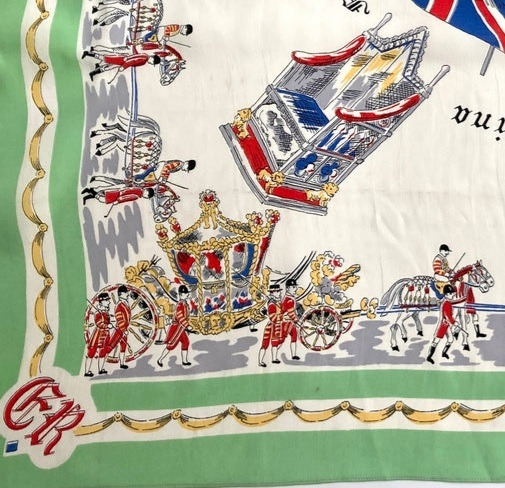
Satin scarf commemorating the coronation of Queen Elizabeth II, 1953
Brand Spanking Vintage, £75
Featuring the Coronation Chair, the Gold State Coach and Household Cavalry, and the Royal Coat of Arms of the United Kingdom.
#coronation#history#elizabeth ii#fashion#fashion history#silk scarf#headsquare#foulard#print#commemorative#1953#1950s#unicorn#lion#coach#coronation chair#coat of arms#heraldic beast#surface pattern#pattern#textile design#printed textiles
12 notes
·
View notes
Text
The Coronation Chair: Anatomy of a Medieval throne
The Diamond Jubilee of Queen Elizabeth II prompted the first comprehensive archaeological study of the Medieval throne on which British monarchs are crowned.
It has been battered and vandalised over the ages, but unpicking this majestic artefact’s evolution shed new light on both its original form and that of the enigmatic Stone of Scone, as Warwick Rodwell reveals.
10 August 2013
The Coronation Chair has been illustrated and described since the 14th century, and is renowned the world over.
For hundreds of years, this piece of Medieval furniture has played a seminal role in the anointing and crowning of English monarchs.
It was last used at the coronation of HM The Queen on 2 June 1953, the Diamond Jubilee of which was celebrated this year.
To mark the occasion in 2010-2012, the Chair underwent a long-overdue programme of cleaning, conservation and redisplay in Westminster Abbey.
Concurrently, a detailed archaeological study was carried out and the Chair was comprehensively recorded for the first time.
The project led to a radically new understanding of its construction and decoration, and of its relationship to the Stone of Scone, which was embodied in its seat.
Spoils of war
The origins of the Chair are well known. Indeed, the documentation accompanying its manufacture in the 1290s is still preserved.
Following Edward I’s victory over the Scots in 1296, state documents and items of regalia were surrendered and taken to London as spoils of war.
One of those items was a ceremonial block of sandstone upon which Scottish kings had hitherto been inaugurated at Scone Abbey in Perthshire, the last being John Balliol in 1292.

The Coronation Chair and Stone of Scone.
Constructed in the 1290s on the orders of Edward I, this famous throne recently received its first comprehensive archaeological study.
The results emphasise how the current form of the Stone of Scone can only be understood alongside the evolution of the chair that held it.
Edward I treated the Stone of Scone as a relic and presented it, along with the Scottish crown and sceptre, to the shrine of St Edward the Confessor in Westminster Abbey on 18 June 1297.
He ordered the construction of a great gilt-bronze chair to incorporate the Stone as its seat.
The chair was cast but was scrapped before it was finished and a new one made of oak, thereby reducing its weight from three-quarters of a ton to one-quarter.
St Edward’s Chair, as it is properly known (‘Coronation Chair’ is a relatively recent naming), was designed as a liturgical furnishing that would stand close to the shrine altar, where it served as a seat for priests officiating at masses.
Opinion is divided as to when the Chair was first used in the coronation ritual, but it was no later than 1399, when Henry IV was crowned.
A manuscript illustration of the coronation of Edward II in 1308, however, shows the king seated in what is almost certainly the Coronation Chair.
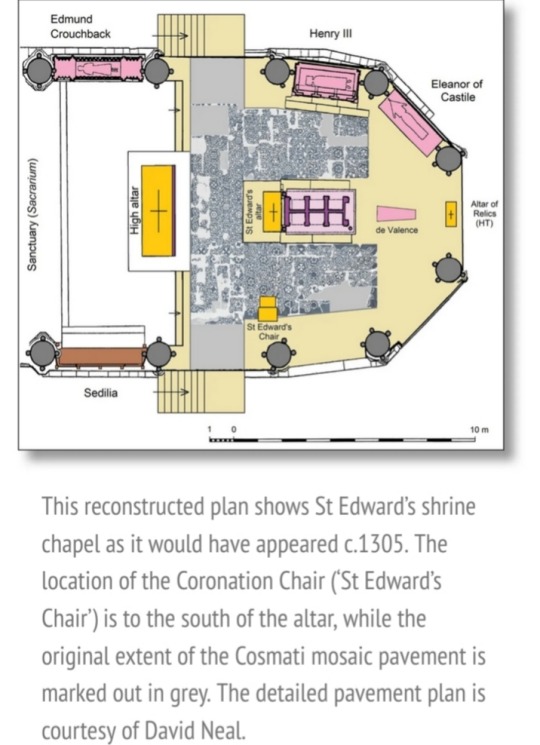
It is an extraordinary fact that, like a surprising number of artefacts and structures of first-rank importance, the Coronation Chair had never been systematically studied and recorded until now.
John Carter’s sketches of 1767 provided the basis for all known drawings but neither he nor any other antiquary recorded how the Chair was constructed or unravelled the vicissitudes of its later history.
Like most ancient artefacts of complex construction, it has undergone fundamental alterations as well as suffered deterioration over the centuries.
In fact, very little has been written about the Chair at all, as opposed to the Stone that it encapsulated.
The Chair has been the subject of a dozen books, scores of articles, Parliamentary debates, a commercial film, theft, hoaxes, and much political posturing.
Myths and misdirection
The Stone has accrued a huge mythology, but that is wholly of Medieval or later invention, as Nick Aitchison demonstrated in his study Scotland’s Stone of Destiny (2000).
The block is made of Lower Old Red Sandstone and has a geological signature that confirms it derives from the Scone Formation.
It did not originate in Egypt, Ireland or the west of Scotland, as the Romantic tales would have led us to believe.
Indeed, the Stone’s spurious biblical connection (as ‘Jacob’s Pillow’ – the stone on which, according to the Book of Genesis, the sleeping Jacob had a vision) was already being ridiculed in 1600 by William Camden.
Much of the Stone’s pseudo-history is of even more recent invention.
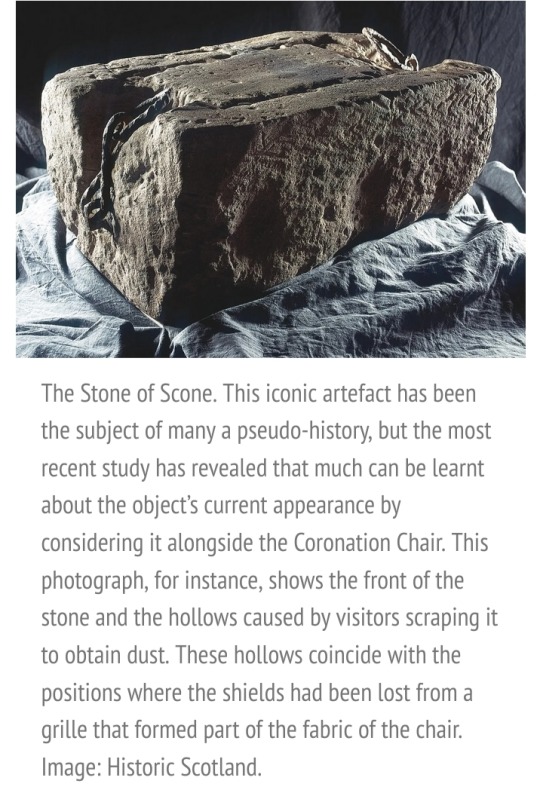
The first archaeologically objective study of the Stone took place in 1996, when it was removed from the Coronation Chair and sent to Edinburgh Castle, where it currently resides on loan from the Crown.
Under the direction of David Breeze and Richard Welander, Historic Scotland carried out a detailed examination, the findings of which were published by the Society of Antiquaries of Scotland: The Stone of Destiny: artefact and icon (2003).
The Stone’s intimate relationship to the Chair has never been explored, however, resulting in the wholly unwarranted assumption by past commentators that the physical features exhibited by the block today relate to its pre-1296 history in Scotland.
This in turn has given rise to the invention of historical scenarios to explain these features.
Some writers have pronounced the block to be a Roman building stone or part of a pagan altar; others have claimed a Bronze Age or Pictish ancestry.
The iron links and rings that are attached to the two ends of the block have given rise to much comment, as well as claims that they were inserted for the purpose of carrying the Stone from site to site in Scotland, or alternatively for transporting it to London.
Finally, there are the conspiracy theorists who would have us believe that the Stone is fake.

These contentions can be refuted without exception. When we study the Chair and the Stone as archaeological artefacts, not just individually but jointly, and marry the findings with reliable historical evidence, a clear picture emerges.
The most fundamental misapprehension is that the Stone (as we see it today) was brought from Scone and placed in a made-to-measure compartment under the seat of the Chair, and that it simply sat there for the next 700 years.
In reality, the Chair and the Stone were made for one another, and both have been subjected to significant change over the centuries.

Made for each other
There is no basis for casting doubt on the authenticity of the Stone of Scone, or for claiming it as a Roman ashlar or a Pictish symbol-stone.
The upper and lower faces are natural bedding planes and are untooled, although the former is well worn through its prolonged use as a seat.
The four vertical edges were all crisply dressed in 1297 to create a close-fitting, rectangular seat for the new Chair.
One of the revelations of the 2010 study was the fact that the Coronation Chair did not have a wooden seat-board until the 16th or 17th century: the Stone itself was the seat.
The Chair frame is made of oak and comprises four corner-posts, and a series of moulded horizontal rails.
The sides of the Chair have upswept arms, which were originally decorated with carved lions.
The joints are mortised-and-tenoned but are inherently weak. The frame gets its structural strength from the lining of thick planks.
Below seat level, the sides are pierced by large quatrefoils – that is, four partially overlapping circles creating a shape akin to a stylised four-leaf clover – each of which originally had a painted heraldic shield at its centre.
By the 1820s, the shields had all been lost, and the quatrefoil grille at the front had gone too.
The gang that stole the Stone in 1950 also smashed the front rail and further weakened the frame. A replacement grille has now been fitted to restore its structural strength.
The Stone of Scone rested in this compartment and could be glimpsed on all sides; its top was fully exposed.

William Lethaby’s 1906 reconstruction of the gilt figure of a king in the back of the Chair. He is depicted seated on a low throne, with his feet resting on a lion. Only the lower part of this image survives today.
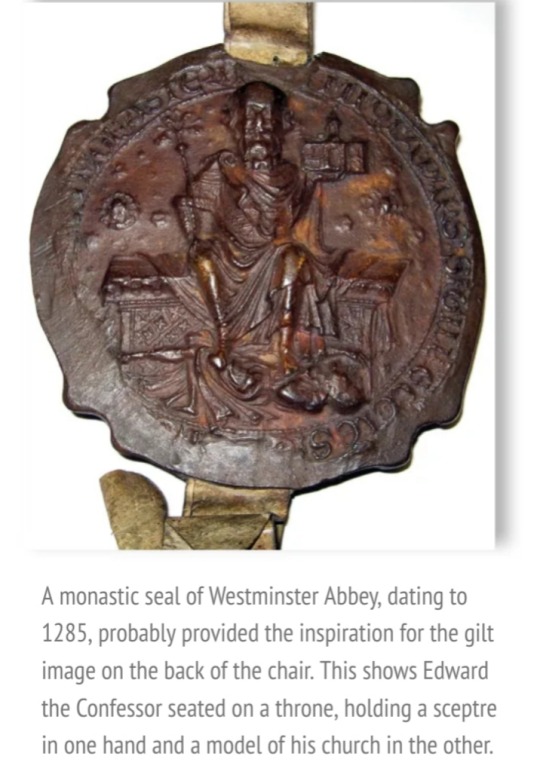
Externally, the sides and back of the Chair were carved and moulded with Gothic arcades.
The corner-posts too were embellished with blind, pointed – lancet – arches, and surmounted by pinnacles from which decorative foliage or ‘crockets’ sprouted.
No timber was originally visible, though, as the surfaces were entirely covered with decoratively punched gilding and pseudo-enamels.
There were also many pieces of coloured glass inlaid into the carved decoration. These inserts would have carried painted and gilded motifs, similar to those found in profusion on the altarpiece of Henry III known as the Westminster Retable (c. 1270).
Internally, the Chair was uncarved but was covered with gold leaf. It bore finely punched decoration - showing birds, animals, vegetation, and Gothic motifs.
Dominating the centre of the back was the seated figure of a king with his feet resting on a lion, almost certainly Edward the Confessor.
It was the work of Walter of Durham, principal painter to the court of Edward I. Unfortunately, most of this impressive display has been lost over time.
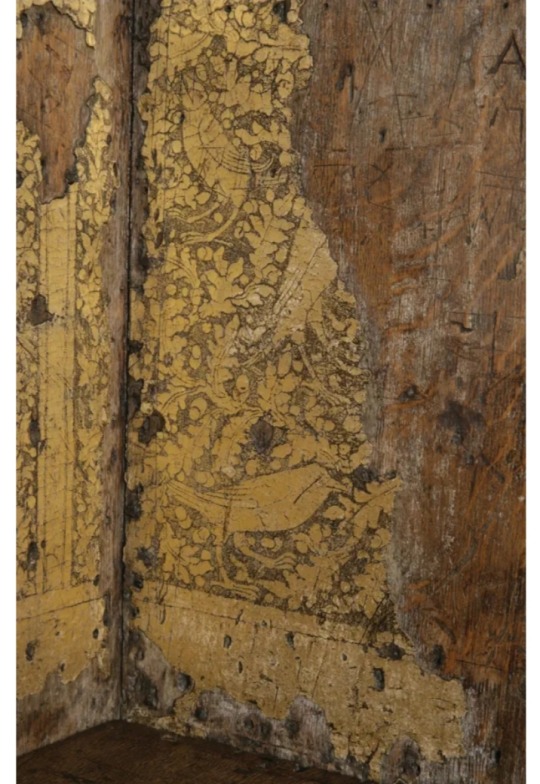
A detail of the punch-decorated gilding surviving inside the Chair’s left arm, showing birds amid vegetation.
The conservation programme of 2010-2012 was undertaken by Marie Louise Sauerberg, then of the Hamilton Kerr Institute, but now Westminster Abbey’s Senior Conservator.
Her work was key to unlocking the history of the Chair’s decoration, particularly by demonstrating that the all-over gilded appearance was primary.
In the 1950s, it had been suggested that the Chair was initially white in colour, emulating King Solomon’s ivory throne.
Royal pride
Perhaps the most striking aspect of the Coronation Chair today is the gilt plinth on which it is raised, comprising four magnificent lions with Oriental features.
These were fitted in 1727 by the royal furniture-maker for the coronation of George II and replaced an earlier plinth, which also incorporated lions.
That plinth may have been made in 1509 for the coronation of Henry VIII.
Since both lion-plinths were fixed to the Chair frame, the Stone could only be inserted into the seat compartment from above, but this was not the original arrangement.
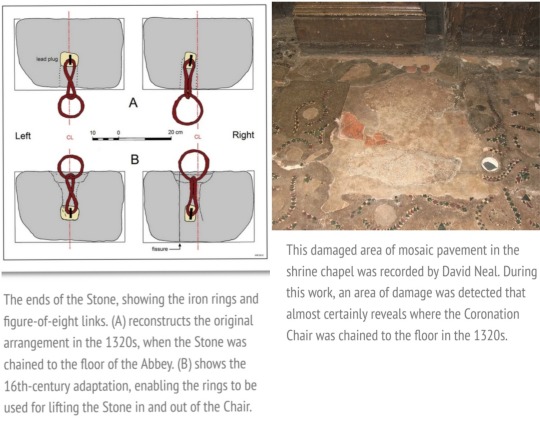
Walter of Durham’s exquisite gilt decoration would have been wrecked by manhandling a close-fitting, 3-cwt block of sandstone through the seat compartment.
Every time the Chair was required for a coronation, it had to be taken from the Confessor’s chapel through a narrow doorway, carried down steps, and repositioned in the Abbey.
Four operations were involved in extricating and replacing the Stone.
Almost certainly, the original plinth was a separate construction that rested on the floor. The Stone was placed on it and the Chair lowered over that.
Iron links and rings are attached to the ends of the Stone by staples set into lead plugs.
Various theories about their date and purpose have been advanced, all based on the assumption that they were used for lifting or carrying.
But nobody seems to have noticed that their fixing points are below the Stone’s centre-of-gravity, which means that it would instantly rotate when lifted.
Also, the links are not long enough for the rings to clear the top of the Stone, making it impossible to thread a carrying-pole of adequate diameter through them.
It is now clear that the ironwork was attached to the block in c. 1324-1327, on the instruction of Abbot Curtlyngton, expressly for the purpose of chaining it to the floor of the chapel.
At the time, he was under pressure from Edward III to relinquish the Stone so that it could be used as a bargaining counter with the Scots.
The abbot refused and the chronicler Geoffrey le Baker tells us that ‘the stone was now fixed by iron chains to the floor of Westminster Abbey under the royal throne’.
Since enforced removal of an object gifted to a shrine would have constituted sacrilege, the king backed down.
The 13th-century marble and glass mosaic pavement in the Shrine chapel has been meticulously recorded by David Neal.
During his work, we noticed that a square area to the south of the altar, where the mass priest’s seat would have stood, had been destroyed.
Almost certainly, this marks the place where the pavement was broken through in the 1320s to embed anchors in the floor for the chains that secured the Stone.

When the Chair was fitted with the first of the lion plinths, a new means of manoeuvring the Stone in and out of the seat compartment had to be found: the only route was from above.
The iron fittings were now pressed into service as lifting devices. Channels were crudely cut into the ends of the Stone so that the links could stand up, rather than hang down, and ropes could be passed through the rings.
The tendency for the unbalanced Stone to rotate was largely mitigated by the links being constrained in channels.
It was a clumsy compromise but it worked, albeit inflicting damage on the gilded interior of the Chair, as the Stone was hauled in and out.
The institutional history of Westminster Abbey in the two decades following its dissolution in 1540 is complex, but remarkably, the shrine of St Edward and the royal tombs survived.
The later 16th century saw a fashion for attaching historical labels (tabulae) to features around the Abbey, including the shrine, tombs and St Edward’s Chair.
These were generally painted either directly on the object or on a board, but in the case of the Chair, it seems that there was initially an intention to insert an inscribed brass plate in the upper face of the Stone.
The rectangular outline for the plate was roughly chiselled. The matrix was never fully cut and the project aborted. A painted label on a board was provided instead.
The change of plan most likely resulted from a decision to fit a timber seat-board over the Stone that had two further consequences.
First, battens had to be fitted to the sides of the Chair to support the seat-board, thereby reducing the size of the Stone compartment opening.
The block had to be shortened, and both ends were cut back by c. 15mm.
Second, the iron rings projected above the top of the Stone, obstructing the fixing of the seat.
To solve this problem, housings were hacked into the top of the Stone, allowing the rings to lie flat.
13th-century survival
Since the late 16th century, travellers and antiquaries have written accounts of the Chair, from which we learn that it suffered casual abuse until Queen Victoria came to the throne.
All the glass inserts were prised out, scores of slices were removed from the frame with pocket-knives and taken as souvenirs, names and initials were liberally carved in the wood, and the shields were stolen from the quatrefoils, exposing the sides of the Stone, which was then scraped with knives to acquire samples of its dust.
Three shallow scoops scored into the front edge result from this activity.
In the 18th century, when the second lion-plinth and new seat-board were fitted, further modifications to both the Chair and Stone occurred.
Although the latter had been shortened, the iron staples to which the rings were attached projected awkwardly, gouging the sides of the Chair every time the Stone was moved.
To ease this, the crowns of the staples were filed down. Something even more barbaric happened between 1727 and 1821: the lower edges of the Stone were broken away with nine hammer-blows.
There is no obvious explanation for this – perhaps the pieces were sold as souvenirs.
Even in more recent times, the Chair has suffered periodically.
In 1887, the Office of Works painted it brown for the celebration of Queen Victoria’s Golden Jubilee.
A public outcry ensued and great damage was done to the gilt decoration when trying to remove the paint.
In 1914, Suffragettes attached a home-made bomb to one of the Chair’s pinnacles, causing more damage.
In 1939-1945, the Chair was stored in the crypt of Gloucester Cathedral, where it narrowly escaped destruction by an infestation of dry rot.
Finally, as well as vandalising the Chair, the gang that stole the Stone in 1950 dropped it and broke it.
Given this long and varied history, it is perhaps remarkable that the Chair survives at all.
Yet our study makes it clear that, despite having fallen victim to neglect, politics and the whims of fashion, St Edward’s Chair and the Stone of Scone – in the form we know it today – are two components of a single artefact, made in the 1290s.
They have an integrated physical history, and shared archaeology: one cannot be understood without the other.
#Coronation Chair#St Edward's Chair#King Edward's Chair#Stone of Scone#Coronation Stone#King Edward I#British History#British Royal Family#Queen Victoria#Queen Elizabeth II#medieval throne#Golden Jubilee of Queen Victoria (1887)#Diamond Jubilee of Elizabeth II (2012)
52 notes
·
View notes
Text
Jaspa and the Coronation Chair
Most of the world knows that King Charles was coronated earlier this month. Slightly fewer people are aware that the throne on which he was crowned features not once, but twice, in Jaspa’s Journey 2: The Pride of London.
King Charles and the Coronation Chair during his coronation on May 6th (photo: Getty Images)
Actually, while researching The Pride of London, I was surprised to learn that the…

View On WordPress
#Children&039;s literature#Coronation Chair#London Bridge#Middle-Grade Fiction#Tower of London#Westminster Abbey
7 notes
·
View notes
Text
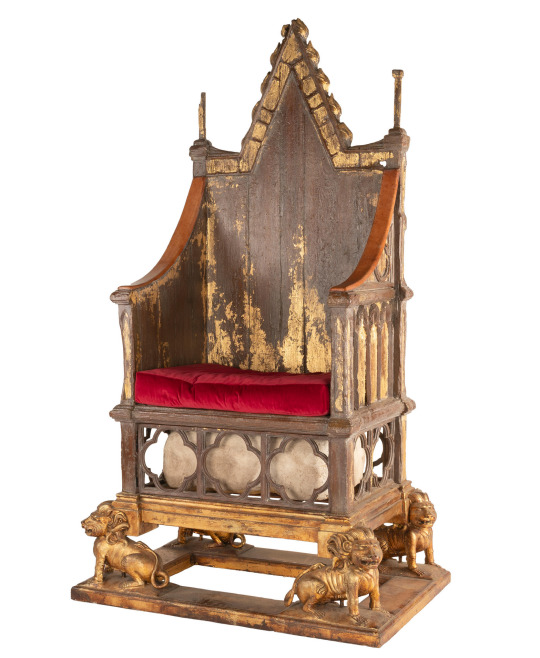
Replica Coronation Throne & Stone of Scone
The Crown
Gold-painted and simulated oak fibre-glass throne faithfully recreated after the Gothic original, the arched panelled back with downswept arms mounted with tan leather, with Gothic arched panelled sides above a solid seat and pierced quatre-foil frieze enclosing a fibreglass copy of the Coronation Stone of Scone (Stone of Destiny), supported by four lions on a plinth base, with red velvet upholstered squab cushions, together with golden canopy used during the filming of the scene, with turned handles, to be held by bearers; and the Art Department design drawing for the Coronation canopy, the chair: 117cm wide x 72cm deep x 211cm high, (46in wide x 28in deep x 83in high) (3)
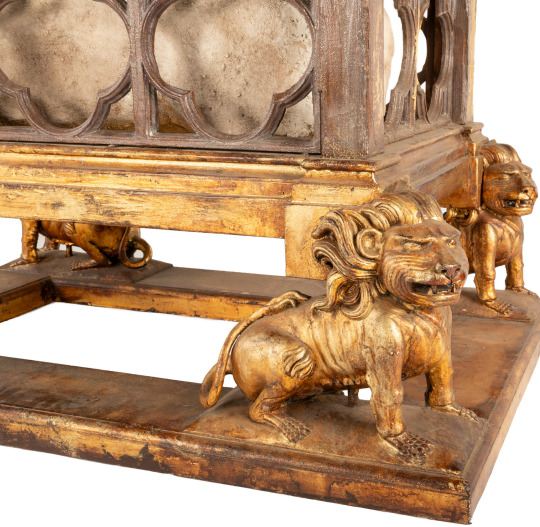

via: https://www.bonhams.com/auction/29243/lot/20/a-reproduction-of-saint-edwards-chair-the-coronation-chairseason-1-episode-5-smoke-and-mirrors-3/
0 notes
Text










#westminister abbey#history#art#london#britian#statue#tribute#death#coronation#coronation chair#politics
0 notes
Text
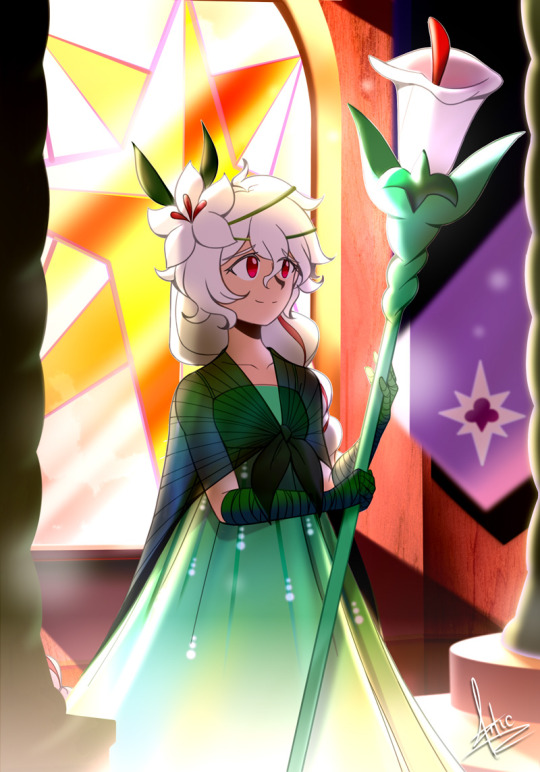
"White Lily Cookie! You made it!"
#cookie run#cookie run kingdom#white lily cookie#쿠키런킹덤#クッキーラン#fanart#kinda based on Pure Vanilla's coronation scene#also I still don't have white lily cookie aaaaaaaa *bites a chair*
31 notes
·
View notes
Text

Queen Charlotte by Allan Ramsay, 1762.
#classic art#painting#allan ramsay#scottish artist#18th century#portrait#female portrait#indoor portrait#queen charlotte#charlotte of mecklenburg-strelitz#queen#queen of great britain#house of hanover#coronation robes#chair#palatial interior#columns
52 notes
·
View notes
Text
Well the coronation sounds like it’s going to be boring as shit
#coronation#british royal family#I want escapism#Charles using a desk chair instead of a velvet chair won’t end poverty#so just let me live vicariously through these people!!!
21 notes
·
View notes
Text
seeing as I am currently a citizen of the UK and spitting mad about this:
I owe no allegiance or obedience to that line of smug entitled parasites, and even if I did think that way before the fact that they are spending tens to hundreds of millions on a party to celebrate how important they are in a time like this and plastering that arrogant grinning face everywhere would be enough to break me of it
we live in a goddamn democracy the only thing I owe him is to apparently restrain myself from throwing eggs in his face in the street
#also TIL that oath is part of the ceremony for people who apply for citizenship and eeesh#I was already sorry for everybody who had to go through that process but learning you end up *there*?#we had WARS over this shit or does he not remember what happened to the first of his namesakes#if they wanted to run a republicanism recruitment drive I don't think they could do much better#we're a goddamn democracy I will not pledge any allegiance to a man whose job is to sit on a fancy chair and wave at people#politics#coronation#rain tea and complaining
4 notes
·
View notes
Text
Wait what the fuck do you mean they made a Rainbow Magic Fairy based on King Tampon-

#'charles the coronation fairy' please take him back#i can almost forgive the existence of the other royal events themed fairies#(especially as the meghan fairy is really nicely designed)#but not this one nooo#also the plot is he gets kidnapped with his magic item by jack frost and just#damn may have to let jack frost have this one#just may have to let him#also apparently the coornation in this book is prince arthur and just#dont get my hopes up book#we still awaiting him to show up with the steel chair
4 notes
·
View notes
Text




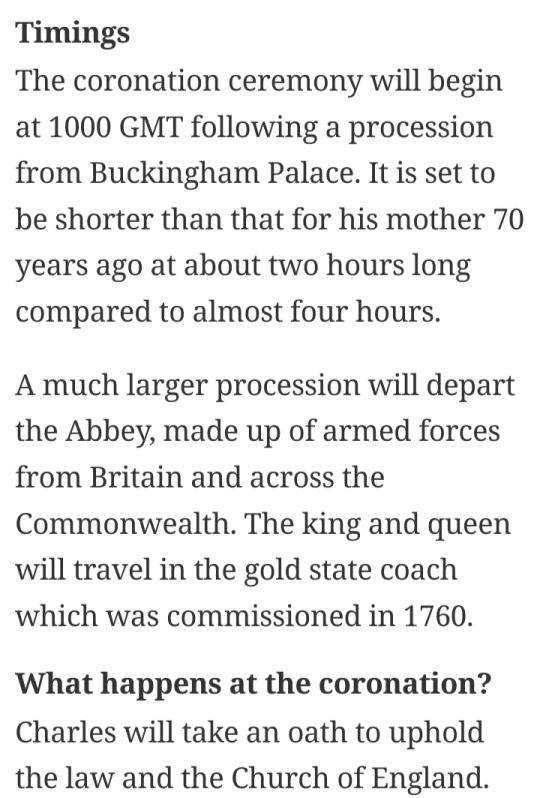

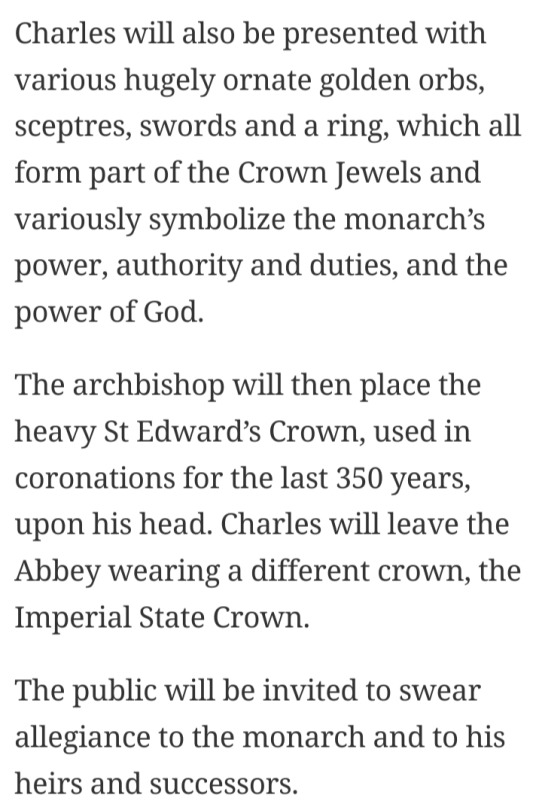
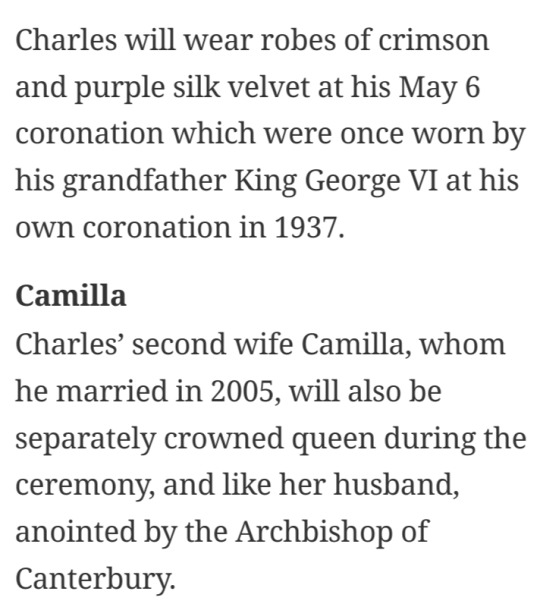
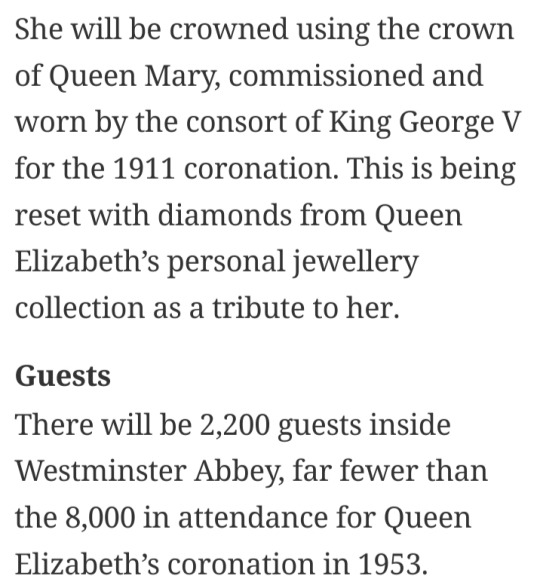

Edited
#King Charles III#British Royal Family#Coronation Ceremony 2023#coronation#Buckingham Palace#Westminster Abbey#Coronation Chair#St. Edward's Chair#Stone of Destiny#St. Edward's Crown#Imperial State Crown#Crown Jewels
3 notes
·
View notes
Text
[ -photo of Danny sitting on the sovereign throne, he has a Christmas cracker paper crown on, some rope in place of gold chain, a stick with a popped out sunglass lense tapped to it as a sceptre, and curtain far too fine to be found in the trash for a cape- ]
Said bout an hour right?
There we go. UK - conquered. And I own London specifically now.
#ic#I know the coronation chair is a different chair but this one is more fancy lookin so for the drama#// and i would of drawn this but ive shut my computer down for the night
6 notes
·
View notes
Text

Queen Victoria of England
Artist: George Hayter (English, 1792–1871)
Title: Queen Victoria (1819-1901)
Genre: Portrait
Date: 1840
Medium: Oil on Canvas
Collection: Royal Collection of the United Kingdom
Description
Before his appointment as Queen Victoria’s ‘Painter of History and Portrait’ in 1837, George Hayter had impressed the young Princess with his skill as a portraitist and helped her with her first attempts at oil painting. Hayter was to succeed Sir David Wilkie as Principal Painter in Ordinary to the Queen in 1841. However, he received no royal commissions after 1842 as the Queen came to prefer the work, and personality, of other artists - particularly Sir Edwin Landseer and Franz Xaver Winterhalter. Queen Victoria commissioned this, her State Portrait, from Hayter in 1838. The 19 year-old Queen is depicted as she was at her Coronation in Westminster Abbey on 28 June of that year. Shown seated in her Homage Chair, she wears Coronation Robes and the Imperial State Crown and carries the Sceptre with the Cross.
Hayter’s first background for the painting showed the Queen in Westminster Abbey, but he was to alter this later, placing her in a more generic regal setting. Queen Victoria’s pose, with her upturned face illuminated by a shaft of light, endows the composition with a religious spirit reminiscent of Baroque painting. In fact the day did not proceed smoothly, as the Queen was to relate in her journal. For instance, the Coronation Ring, which had been made to fit her little finger, was forced on to her fourth finger by the Archbishop and the unfortunate Queen had to bathe her hand in iced water after the ceremony before she could remove the ring. There was, according to Lord St John, the Sub-Dean, ‘a continual difficulty and embarrassment, and the Queen never knew what she was to do’. Nevertheless, she described the day as ‘the proudest of my life’.
#portrait#queen victoria#sir george hayter#coronation robes#homage chair#imperial state crown#spectre with cross#queen of england#english painter#english history#british royals#19th century art#19th century england
0 notes
Photo
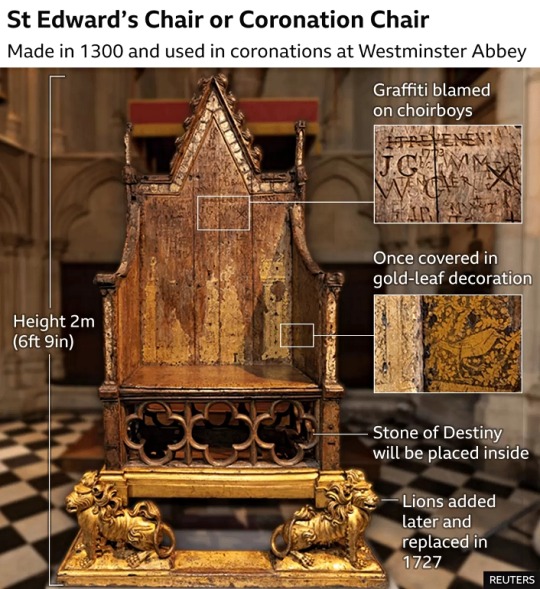
^^^ Not exactly the Iron Throne, but probably more comfortable.
At his coronation, King Charles III will get to sit on a 700 year old piece of furniture called St. Edward’s Chair. It was built in 1300 which would be Late Medieval times. In terms of culture and technology, that corresponds to the setting of Game of Thrones and House of the Dragon – minus any fantasy elements.
The BBC says about the chair...
The Coronation Chair, also known as St Edward's Chair or King Edward's Chair, is believed to be the oldest piece of furniture in the UK still used for its original purpose. A total of 26 monarchs have been crowned in it.
The late Queen Elizabeth II did visit the GoT set in 2016. But she declined to sit on the Iron Throne.

Afterwards I heard that there is an obscure law that the British monarch may not sit on a foreign throne. I never verified that, but it would seem to imply that King’s Landing isn’t in the United Kingdom.
#game of thrones#the iron throne#charles iii#coronation#st. edward's chair#elizabeth ii#gra o tron#trône de fer#kampen om järntronen#pemainan takhta#juego de tronos#jogo dos tronos#trono di spade#isang kanta ng yelo at apoy#taht oyunları#loja e froneve#spiel der throne#trò chơi của ngai#гра престолів#왕좌의 게임#权力的游戏#ゲームの玉座#صراع العروش#গেম অব থ্রোনস#تخت کے کھیل#गेम ऑफ़ थ्रोन्स#ഗെയിം ഓഫ് ത്രോൺസ്#משחקי הכס#игра престолов#παιχνίδι των θρόνων
1 note
·
View note


